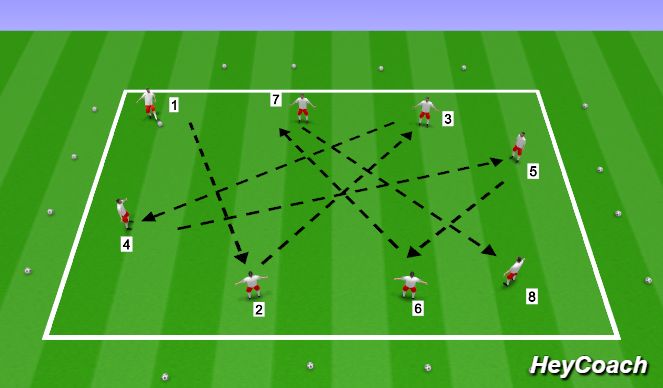
Organization:
1. 30 x 30 yard area set up as shown
2. 3x3x3 yard triangles (Mouse Holes) set up throughout area
3. Half of players start in triangle with soccer ball
4. Half of the players in area without soccer ball
5. All Players (Jerry's) have a pinny hanging out their shorts to represent a tail
6. Tom starts the game inside his liter box
Description:
1.Players have to avoid losing their tail. You can lose your tail if Tom comes to eat (take out of shorts) it before you get into a mouse hole
2.Once inside a mouse hole you are safe from Tom's paws.
3. Only one Jerry can be in a Mouse Hole at anyone one time.
4. If you are accupying a mouse hole and another Jerry runs into your Hole you MUST leave that hole IMMEDIATELY or risk losing your tail.
P.S. When leaving the Hole you cannot leave the through the same side that another mouse enters from
5. Game ends when Tom collects all the Tails or if the kids get too tired.
Coaching Points:
1.Head up to observe open mouse in mouse hole
2.Communication between players
3.Push pass inside square
4.Open body up to receive on back foot
5.Head up to observe next action
Progression:
1.R - Ball cannot leave the same side of the square it entered from
2.R - Add a roaming defender that must prevent passes into the squares

Organization:
1. 40 x 30 set up as shown
2. 8 players set up as shown
3. 1 ball (Additional around the outside)
Instructions:
1. Number each player 1 to however many you have in the session. In the diagram above there are 8 players numbered 1-8
2. The game is to pass to each player following the sequence of number. For example 1 passes to 2, 2 passes to 3, 3 passes to 4, etc.
Coaching Points:
1. Getting into line with the ball
2. Assess the situation as ball travels
3. Select appropriate surface
4. Directions of touch to enable next action
Progressions:
1. P – Add extra ball(s)
2. R – Players have to pass the ball using hands

Organization:
1.40 x 20 yard area set up as shown
2.8 players set up as shown
3.4 balls (Additional around the outside)
Instructions:
1.Divide the group into two, four players on each side 10 yards apart
2.Place a cone between the two players, 10 yards from player to cone 20 yards overall
3.Place a ball on top of the cone
4.The game is to see how many times a player can knock the ball off the cone using various passing techniques
5.If player a knocks the ball of the cone then they replace the ball back on top of the cone while their partner gets ready
Coaching Points:
1.Head up to observe target
2.Ball contact - middle
3.Ankle locked, toe pointed up
Progressions:
P – Players can score double points if they are able to play a 1 touch
R – Decrease the distance between player and cone

Organization:
1.Two 20 x 30 yard areas as shown
2.Two teams of 5 players
3.Lots of soccer balls with coach
Description:
1.The Coach passes a ball into each area, teams send two players into opposing half to play 4 v 2
2.Defending players attempt to steal ball and return it to their own area
3.If successful, play 6 v 2 with 2 soccer balls for as long as possible
4.Attacking team scores points for every pass completed when both soccer balls are in their own area
Coaching Points:
1.Speed of play
2.Importance of using 1st touch to move away from pressure
3.Keep the ball moving
4.Awareness of space
5.Combination play to keep defenders moving and unbalanced
Progression:
1.P - Add 3rd defender if attacking team keep both balls for a set period of time
2.P – Send only one player over to defend to play 5v1

Organization:
1.30 x 20 yard area set up as shown
2.6 players (2 teams of 3) set up as shown
3.6 balls
Instructions:
1. Players must complete 5 passes before taking a shot on goal
2. Goal kicks, corner kicks and throw-ins when the ball goes out
Coaching Points:
1. Angle of approach
2. Prepare the ball in the direction you wish to play to next
3. Use the nearest surface of the nearest foot to play quickly
4. Look around, see pressure before receving the ball
Progressions:
P – Open play
P – 2 touch max.